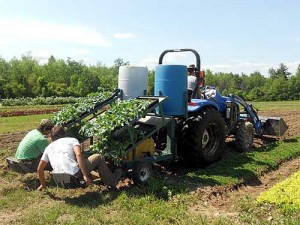Farmers under 40

Ian Ater and volunteers use a tractor and transplanter to set new rows of seedlings at Fledging Crow Vegetables, near Keeseville.
This morning we’re starting a special week-long series on farmers under 40. You’ve seen them. Selling vegetables, or meat, or cheese at the farmer’s market. Driving giant tractors across vast fields of corn.
The demographics of farming have been grim for decades. In the North Country the story has long focused on dairy. Cows and corn, and milk.
It’s dairy country here, and the number of families making a living from traditional dairy farming has plunged.
But there’s a bit of a counter trend, driven by people with a familiar passion for farming, but whose vision takes in a startling variety of crops, methods and marketing strategies.
It’s hard to put numbers to the young farmer trend. The last agriculture census was almost five years ago. But here’s what we know from that data:
In 20 years, the North Country lost 50 percent – – half – of all of its dairy farms. But the total number of farms has dropped by just 10 percent. It’s relatively new vegetable, fruit, and livestock farms that are picking up the slack.
Many are owned by young people. Forty percent of all farms in Franklin and Essex counties, dairy included, are owned by beginning farmers.Beginning farmers own 30percent of the farms in St. Lawrence and Clinton counties, 25percent in Jefferson and Lewis counties.
This week we’ll hear from farmers off all kinds – but all young.From traditional dairy, to alternative small farms. We’ll hear about the tough economics of farming, and we’ll look at liberal arts colleges who are stretching their curricula to meet a new curiousity about farming, and sustainable living.
Tags: farmers40








Speaking of using social networking to promote local food production… check out the Glens Falls Co-Op (still in organizational stage), the impetus for which was started via Facebook.
http://www.facebook.com/#!/groups/glensfallscoop
The non-traditional farmer in northern NY is in a tough spot. Markets are very limited, the season is short, the costs high. I’ll be interested to see what you’ve found that works.
In California – a rich agricultural state – you need 500 acres minimum to be an economically viable traditional farmer. (so I was told as an agricultural graduate student at a California Ag College).
I hope the north Country non-traditional farmers can figure out a way to make it work.